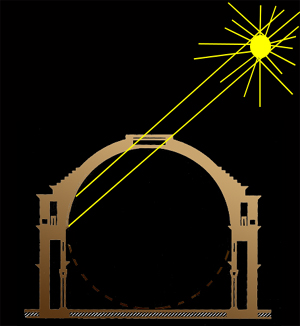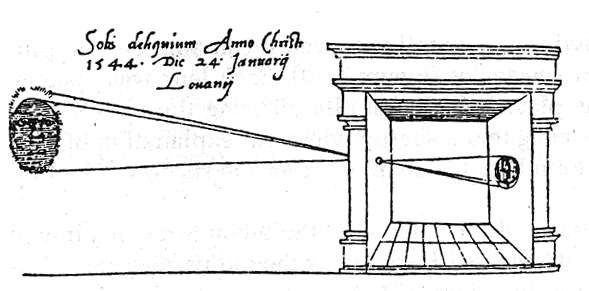Portals - a series photographs exploring natural and constructed openings that act as a Camera Obscura - 1993 - © Lloyd Godman
Text
The Darkened Chamber
If we, like those in Plato's cave, look only inward, we see the shadows on the wall cast by the flickering fire. We mistake the shadows for reality when we could turn our heads and look, hopefully without being blinded, into the glare of the cave's opening, to gain a brighter truer picture. This external reality is the
only one that we collectively can hope to know. 1
As legend and myth would have it, darkness and light have been fighting with each other for millennia. The first dawn rays of each day push away the darkness; with light a tangible landscape opens up for the human eye. The rising sun chases away the evil spirits, the faire spirits, that lurk and hide in the cloak of darkness. Then, as it must, each day the darkness strikes back, it slowly it regains its strength, it catches the light unawares, binds it up and it locks away the light.
This binary code of light and darkness is the most fundamental, and features in the creation myths of many cultures.
From
The Offspring of the Earth and the Sky
In the beginning were Rangi and Papa, Sky and Earth. Darkness existed. Rangi adhered over his wife. Man was not A person arose, a spirit who had no origin; his name was Rangi-tokona, the Heaven-proper. He went to rangi and Papa, bid them go apart, but they would not. Therefore Rangiokona separated Rangi and Papa, he thrust the sky above. - Then for the first time was there light between the sky and the Earth; the world existed. 2
And from the Bible the first words again play light with darkness.
Genesis
In the beginning God created the heaven and the earth . And the earth was without form, and void; and darkness was upon the face of the deep . And the Spirit of God moved upon the face of the waters. And God said let there be light: and there was light. And God saw the light, that it was good: and God divided the light from the darkness. And God called the light day, and the darkness he called Night. And the evening and the morning were the first day.
And God said let there be a firmament in the midst of the waters, and let it divide the waters from the waters.
And God made the firmament, and divided the waters which were under the firmament from the waters which were above the firmament: and it was. And God called the firmament Heaven. And the evening and the morning were the second day. And God said, Let the waters under the heaven be gathered together into one place, and let the dry land appear : and it was so. And God called the dry land Earth, and gathering together of the waters called the seas: and God saw that it was good.
The darkened chamber exists as a cave, an opening in the earth where Rangi-tokona prised Rangi (sky) and Papa (Earth) apart and in the process pulled plugs from the earth leaving hollows and opening in the ground. A place where the light never fully reached. Fissures, cracks, clefts, schisms openings to the underworld.
Natures caves became shelters . A place of revelation, enlightenment. The mysterious nature of the dark, facing outward towards the light, an abstract contrast where the light cuts through the entrance. A place to hide to think. Jesus took refugee in a cave, leppers
Hokioi rere po, pekapeka rere ahiahi (the hokioi flies at night the bat flies in the evening. The Hokioi was a legendary bird which could never be seen, but whose screech was heard at night. The superstitious Maori was frightened of the fearful night bird. 3
A place where the dead where buried
Night and day endless cycles.
The sighted and the blind.
Constructed, the darkened chamber also exists. The architecture of the ancients
From the time when humans first made images on the walls in the caves at Lascaux France a darkened chamber, has been associated with image making. The darkened chambers of constructed dwellings and religious buildings.
And the play of light in the Pantheon in Rome. Built under Hadrian (AD 117-138) on the site of an earlier temple. Light preices through an opening in the ceiling and dances through the space with an ambiance, both darkened and lit an interplay. Perfect design. Consisting of two parts a traditional rectangular temple-front portico with massive granite columns, and behind an enormous domed rotunda. One passes from a world of hard confining angular forms into one of spherical infinity, which seems almost to have been created by the column of light poring through the circular eye orb oculus of the dome and slowly, yet perceptibly, moving round the building with the diurnal motion of the earth.
Page 163

Move over image to view roll over image
While light and the camera have always been synonymous with photography, the concept and use of the camera is much much older than photography.
The Gallery
The word camera obscura is also used as a term for the first camera devices, and the principal can be traced back to Aristotle. Aristotle's (384 - 322 B.C.) power of observation was as remarkable as his fortitude in writing down and systematizing what he observed. One afternoon there was a partial eclipse of the sun. Aristotle noticed that he if he stood beneath a tree whose leaves formed a mesh, that he could see an image of the sun an its eclipse projected onto the ground. He attempted to repeat the phenomenon using a strainer. It worked. Further experiments showed him that the smaller the hole in the strainer, the sharper the image produced. The photographic projection below resembles what Aristotles must have see through the leaves during the eclipse.
Aristotle even extrapolated the principle responsible for this occurrence. He explained that light rays are straight lines. When light rays proceeding from a very bright object meet a dark surface with a small hole in it, the rays passing through the hole do not scatter, but cross and reform on a surface beyond the hole. The crossing of the rays accounts for the image produced being upside down. This is the principle behind the camera obscura, or "dark room." And it is the principle behind the camera as well.It was noticed that if a very small hole penetrated the outside wall of a darkened room, an image of the scene outside was projected onto the opposite wall. Later, through the dark ages, reference to it can be found in the writings of Arabian scholars who preserved aspects of ancient Greek knowledge. It was found that the brightness of the image related to the size of the hole, ( the larger the opening the brighter the image) and the distance the light traveled from the hole to the wall where the image was formed, (the further the distance the dimmer the image). This effect is termed the inverse square law.
It was also discovered that while increasing the hole allowed more light to enter it also made the image less sharp.

The recognition of this phenomenon where an image of the outside world is projected back through a small opening is very old.
Gemma Frisius, observing the solar eclipse apparently the first published illustration of a camera obscura. 1544
But, soft! What light through yonder window breaks? It is the east, and Juliet is the sun.
--From Romeo and Juliet - 1595 - Act II. - Scene 2. - Rows: 1-2
Romeo Montague has climbed the orchard gate onto the property of the Capulets, his family's dire enemy. He has met Juliet at a party and is now madly in love with her. Hiding in the shadows of the garden below, he waits to catch a glimpse of his love, and in this scene a light goes on in her window and she appears on the balcony, unaware that Romeo is below. Romeo quietly expresses his love (comparing her to the rising sun) and his delight in her unexpected
appearance, but does not reveal himself for some time as Juliet, believing herself alone, begins to speak.
shakespeare
Not too much notice was taken of Aristotle's discovery until Leonardo da Vinci wrote of it in the Renaissance. What really kicked the camera obscura into world-class entertainment, however, was the work of Giambattista della Porta. He was a fascinating man in his own right, and you'll be glad that you clicked here to visit my page on della Porta and what's so special about him. It was his description of the camera obscura in a chapter in Della Porta's amazing twenty-volume book about everything Natural Magick (1558) that did the trick. Click here for that chapter. It was della Porta who came up with the idea of fitting the hole in the camera obscura with a lens.Johannes Kepler also made significant contributions to the repetoire of lenses and prisms.
Aristotles's discovery led to two different traditions of inventions, although the products of both traditions were called camera obscura, or "dark room." In one tradition, the name was quite literal. A room was made very dark, with opaque material covering all the windows. In one of the window coverings a tiny hole was made, and attention of focus in the room would be a smooth surface on the wall parallel to the the aperture. Depending on the shape of the room or the building, the hole might be placed in a wall or on the roof.. Convex and concave mirrors, often on swiveling diases added to the direction of the camera obscura's "vision."After lens and convex and concave mirrors were added, these camera obscura became popular venues for tourists, especially in the nineteenth century. The other tradition of invention miniaturized the camera into a box small enough to carry. These instruments were used to capture clear images of objects onto paper, for the purposes of accurate drawing. These camera obscura were cameras just waiting for film to be invented.
Be sure to click THIS to go to my nifty page in which I graphically demonstrate what Aristotle was talking about and why the peculiar detail he noticed beneath a tree during an eclipse is the key to the photographic culture we are immersed in today.
Referenceces
1 Paul Thompson, Maori Rock Art an ink that will stand forever, GP Books
2 Antony Alpers, The World of the Polynesians, seen through their myths and legends poetry and art, Oxford University Press
3. A.W. Reed with A.E. Brougham, The concise Maori Hand Book, Reed
|